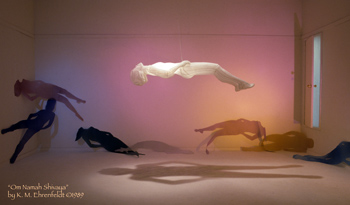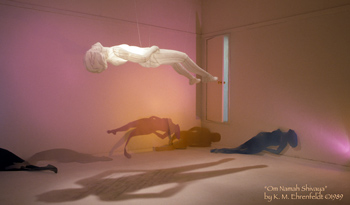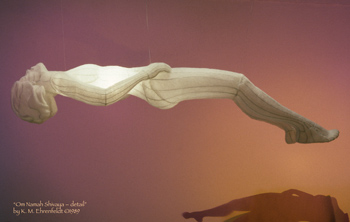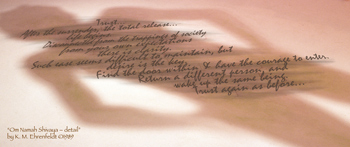 Om Namah Shivaya- full view |
 Om Namah Shivaya- full view |
||
 Om Namah Shivaya- detail |
 Om Namah Shivaya- detail |
||
|
|
|||
2/21/1989–3/31/1989, San Jose, CA
8’ tall x 19’ wide x 13’ deep
Copper wire, aluminum screen, fabric, light, sound, words
This installation juxtaposes the condition of a spiritual being versus a physical being, and the tension of embodying these polarities of existence at once. Feminine concerns are expressed in light and shadow, of vulnerability and trust in the elevated figure, versus the strength and stance of the shadow form below. Artists can only present an image based upon themselves. And, K. M. Ehrenfeldt was working through her growth into womanhood at that time of life, this piece while personal, is not limited to herself or her own experiences, nor that of a woman. Om Namah Shivaya is a Hindu chant that means, “I surrender with great love and respect to my higher self,” and was a focus of the artist's meditations during that time. The artist sought to convey some of her own experience, offering the viewers an opportunity to experience through art what might be touched in the ephemeral moments of meditation. During the show, the 15-minute soundtrack played on a loop, designed to support an experience from instinctual to transcendant. The soundtrack was composed of samplings of singing-like animal sounds, traditional instruments, classical music, and Tibetan bowl tones. The artist's journal entry of her experience in the installation space listening to the soundtrack and observing the space can be read in the comments section below. The prose in the shadow reads:
Trust...
After the surrender, the total release...
life begins.
Disconnected from the trappings of society
from your own expectations
there is clarity.
Such ease seems difficult to maintain, but
desire is the key.
Find the door within & have the courage to enter.
Return a different person, and
wake up the same being.
Trust again, as before...
Sharon Schrama wrote, “There is a sense of trust created between the viewer and the artist. The installation is both vulnerable and ephemeral…The viewer is allowed the privilege of being included in this religious offering. It is a valuable and risky piece as the artist is exposing herself, which makes the experience very moving. I was absorbed by the work and held in awe by the beautiful figure and the metaphysical enticement of the opened door.”
Journal entry, March 29, 1989
The color of light that most identifies itself with this piece is a rosy-orange glow, vibrant, yet soothing to be in. The blue is icy cold, empty there, with a feeling of a void, and almost disturbing by contrast. The cries of a loon and coyote reinforce the disturbing feeling, then there’s silence, a time of waiting, anticipation, but the rumbling of a thunderstorm signals a break. A wind melody interrupts the silence, and integration begins as the Indian flute plays, solid at first, then begins to shake loose when the rhythm picks up.
Abrupt change signals separation later when a Beethoven piece draws your eye to the strength and purpose of the shadow. Drifting upward, signs of death enter in during the Gregorian chants, somewhat of an eerie quality, unsettling in its devotion. As the playing continues, the mood settles in as loving devotion, suddenly broken by curiosity – is it a baby cry? No, an animal – mental activity, what is it saying? More animals in song become disturbing, yet mentally distancing, diffused thinking is now reinforced by the Tibetan bowl’s tone resonating calmly. From this space, there is a desire to drift up and out, it is the sound of the floating figure, elevating, rising up.
Hard to focus on the words in the shadow now. An almost comic feeling emerges as a cheerful tune plays, then the freedom and ease with birds chirping. Aloft now myself, I have left the piece, I’m somewhere else, happy, contented. But as soon as the cry of loon begins again, it shatters the mood, I’m drawn back down and see the broken images along the wall. Now I read the words of the shadow poem, and I understand what I experienced. I look at the elements and see the initial meaning.
After experiencing the sound and its effect on the piece, I let it drift into the back of my conscious mind. I see other aspects now, how the shadows of viewers separate when entering the space, fuse at the center, then separate again. The shadow is so solid, strong and grounded, it contains the message and is the counterpart to the elevated form. Perhaps in order to be free, one truly needs to be grounded at the same time.
K. M. Ehrenfeldt